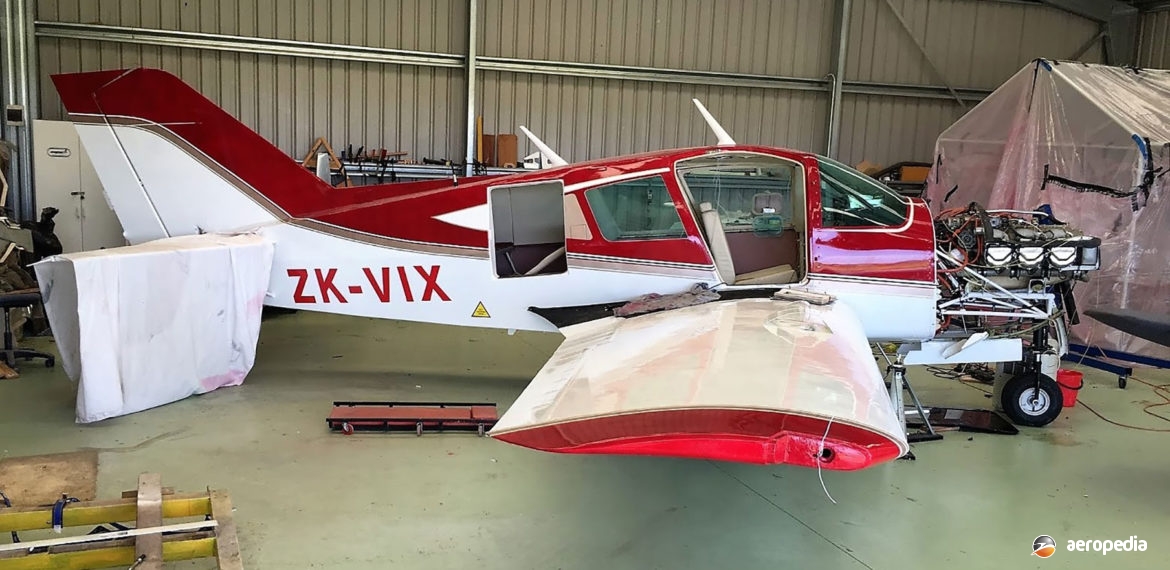Photograph:
Bellanca 17-30 Super Viking ZK-VIX (c/n 79-30944) at Parakai, West Auckland Airport, NZ during its rebuild (NZCIVAIR)
Country of origin:
United States of America
Description:
Four-seat light touring monoplane
Power Plant:
One 224 kw (300 hp) Continental IO-520-K1E5 six-cylinder horizontally-opposed air-cooled engine
Specifications:
- Wingspan: 10.41 m (34 ft 2 in)
- Length: 8.03 m (26 ft 4 in)
- Height: 2.24 m (7 ft 4 in)
- Wing area: 15 m² (161.5 sq ft)
- Never exceed speed: 306 km/h (227 mph)
- Max cruising speed: 306 km/h (190 mph)
- Climbing speed: 201 km/h (125 mph)
- Approach speed: 145 km/h (90 mph)
- Max crosswind component: 32 km/h (20 mph)
- Stalling speed flaps up power off: 115 km/h (71 mph)
- Stalling speed flaps down power off: 94 km/h (59 mph)
- Rate of climb: 368 m/min (1,210 ft/min)
- Service ceiling: 5,182 m (17,000 ft)
- Range at 72% power: 1,160 km (720 miles)
- Range at 56% power: 1,650 km (1,025 miles)
- Fuel capacity standard: 227 litres (50 Imp gals)
- Fuel capacity optional: 282 litres (62 Imp gals)
- Empty weight: 1,006 kg (2,218 lb)
- Loaded weight: 1,508 kg (3,325 lb)
History:
The Bellanca Viking and Super Viking single-engine high-performance touring aircraft with a retractable tricycle undercarriage was manufactured in the United States initially by Bellanca from 1967, 1,356 examples having been completed by the time production concluded in 1975. The aircraft, like most Bellanca designs, was designed by Guiseppe Bellanca.
The series was developed from the 14-13 Cruisair, which was built in the 1950s. Bellanca closed down shortly after and Downer Aircraft obtained the Type Certificate and commenced further development, fitting a Continental O-470 engine in an airframe. The new model then became known as the Model 260. Development through a number of models continued for some years until the Viking appeared, being initially a variant of the Model 260 but fitted with a 224 kw (300 hp) engine.
The first production aircraft was the Model 17 Viking in 1967 which became known as the Model 17-30 with a 224 kw (300 hp) Continental IO-520-K engine driving a three-blade Hartzell propeller. In 1969 a new model known as the 17-31 appeared with a 216 kw (290 hp) Lycoming IO-540 engine, later power being increased to 224 kw (300 hp). A turb-ocharged variant became known as the 17-31TC.
Initial production aircraft had a hydraulic system to operate the undercarriage and flaps, but in 1968 this was changed to electrically- operated. Further changes to the design led to the A series, ie 17-30A, 17-31A and 17-31ATC Super Vikings, and these had a new fuel system installed from 1974. In 1979 the Lycoming powered 17-31A was removed from production and in 1996 a new model with a Continental IO-550 engine was made available.
In 2002 a group of six Bellanca owners obtained the Company and rights to the design from the State of Minnesota and established a company known as the Alexandria Aircraft Company. This company since has provided technical support and parts to owners and operators, and re-commenced production, the first new model being delivered in 2005.
Construction of the fuselage was of welded tubular steel covered with fabric, whilst the wings were built of all-wood (spruce) with a plywood skin.
One example of the 17-30A Super Viking has been imported to New Zealand. This aircraft was built in 1979 and registered as N28045 (c/n 79-30944). After some years of service, in the 1990s it was withdrawn from service at Van Nuys, California for restoration. The fabric was removed but the work was never completed. It was located and obtained by Mr George R Richards of Auckland when he was attending the EAA Air Venture event at Oshkosh, Wisconsin in 2012 and it was subsequently shipped to New Zealand and restored, becoming ZK-VIX (cn 79-30944) to Mr Richards of Helensville on 5 July 2016.

